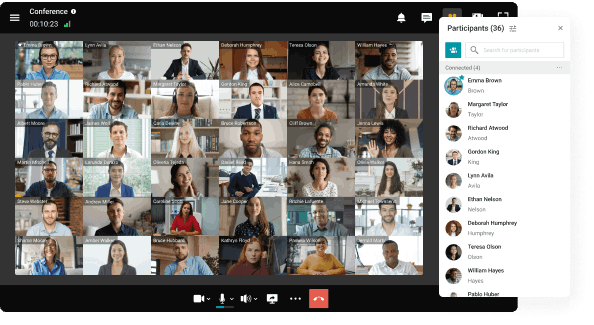Is Zoom Secure?
Zoom has evolved into a leading online conferencing service, especially noticeable during the period of widespread remote employment and digital collaboration. Even with its massive growth, worries about platform safety and confidentiality protocols have appeared. This discussion explores whether Zoom stays dependable, emphasizing its privacy difficulties, security weaknesses, and suggesting strategies to better protect gatherings and sensitive records.
Zoom’s Data Collection and Privacy Practices
What Personal Data Does Zoom Collect?
Zoom gathers various categories of user-related details to operate and maintain its functionality. This covers fundamental information like full names, registered emails, contact numbers, and hardware specifications. Moreover, Zoom monitors supplementary metadata concerning sessions, which can involve IP origins, hardware signatures, and time stamps for meetings. It may also store information tied to meeting contents, such as written chats and uploaded materials, though such content is generally preserved briefly for processing purposes.
Zoom has received criticism regarding the way it distributes user-related records with external partner companies. Reports revealed that the platform previously transmitted certain analytics information to entities like Facebook along with advertising collaborators. For example, the iOS application from Zoom once delivered user session statistics to Facebook without securing explicit permission, sparking data protection debates. While the company has later updated policies to mitigate these challenges, the exchange of personal records remains an ongoing concern for participants.
Data Mining and Privacy Concerns
Zoom’s background data-gathering functions have likewise drawn scrutiny, particularly because of a capability that accessed LinkedIn profile information. This mechanism unintentionally revealed sensitive details about individuals without them granting direct approval. These cases highlight why it is crucial to thoroughly examine the specific clauses within a service’s privacy terms to properly grasp how user information might be obtained and applied.
Zoom Security Vulnerabilities
Lack of End-to-End Encryption
A major protection issue surrounding Zoom is the lack of default end-to-end encryption. Although this option exists, it is not switched on automatically. As a result, in numerous cases, Zoom calls are only partially encrypted, which could leave them exposed to interception or unwanted entry. This represents a serious issue for participants dealing with private or sensitive content during online conferences.
Zoom Meeting ID Vulnerability
Zoom meeting identifiers may be easily created by attackers through widely accessible software. This flaw permits unauthorized participants to access meetings without an official invite, disrupting conversations and risking exposure of confidential material. Hosts should apply additional safeguards such as passwords and waiting-room controls to block these types of incidents.
Public Exposure of Zoom Calls
There have been occasions when individual or corporate Zoom meetings were mistakenly made publicly visible across the web. Such situations can arise from incorrect configuration settings or flaws inside Zoom’s cloud-based storage systems. These cases stress the dangers of hosting private calls on a service that stores them remotely without strict protective measures.
Cloud Recording Risks
Zoom’s recording-to-cloud capability, while convenient for documentation purposes, also introduces security concerns. These stored files reside on Zoom-managed servers, which could be subject to breaches unless locked down effectively. Past incidents have shown meeting footage being shared with unintended audiences, illustrating the inherent danger of relying entirely on online storage for critical communications.
Security Concerns During Meetings
One of the most well-known Zoom security problems is “zoombombing,” where uninvited individuals enter a meeting and cause interference. Such disruptions can vary from harmless pranks to major confidentiality violations, especially if private data is discussed. Cyber-intruders may quickly join calls if organizers neglect to enforce passwords or omit waiting-room controls for entry management.
Zoom Adds Strangers to Public Contact Lists
Zoom’s automated mechanism for placing unfamiliar users into shared contact lists has prompted warnings about the potential exposure of personal emails and profile visuals. This weakness endangers user privacy by granting strangers visibility into details outside the intended communication circle.
Hackers Posting Zoom Accounts on the Dark Web
Beyond vulnerabilities in the service itself, reports have surfaced about Zoom login information being traded on the dark-web marketplace. This suggests criminals could log into accounts if those credentials were compromised elsewhere. Strong, distinct passwords and enabling two-factor verification are essential measures to guard against this threat.
Addressing Zoom’s Security and Privacy Issues
Updates and Fixes to Security Flaws
Zoom has taken meaningful actions to resolve security and privacy issues flagged by the community and cybersecurity professionals. The service rolled out stronger encryption methods, expanded authentication tools, and improved granular meeting-management settings. Although these revisions have boosted Zoom’s security reputation, participants must continue staying alert and use the newest protective functions.
Tips for Protecting Your Meetings and Data on Zoom
To lessen risks, Zoom participants should follow essential guidelines for protecting sessions and confidential records:
- Use robust, unique passwords for every meeting to deter unauthorized access.
- Enable waiting rooms so that only approved attendees can join at specific times.
- Limit participant permissions to avoid unauthorized screen-sharing or extra invitations.
- Generate one-time meeting IDs for each event to keep links secure.
How to Identify the Shield Icon in the Meeting Window?
Zoom includes a shield symbol inside the meeting display to signal that the connection is protected. Participants should always check for this mark before starting private discussions to confirm that the session is secure.
Should You Still Use Zoom?
Even with some remaining security gaps, Zoom is still a heavily used and easy-to-navigate video-conference application. Nevertheless, users should actively improve meeting safety by turning on protections like encryption, waiting rooms, and access codes. Those with higher privacy expectations might investigate alternative platforms that have stronger built-in safety measures.
Zoom Alternatives
If considering a transition from Zoom or exploring other options, here are several alternatives that provide secure and comprehensive features tailored for different business requirements:
TrueConf
TrueConf is a secure video conferencing solution designed for both small businesses and large organizations. It offers encryption, safeguarding the confidentiality and security of all meetings and communications. The solution provides flexible deployment options, including on-premises and cloud solutions, ensuring it can meet the specific requirements of any business.
With high-definition video and clear audio, TrueConf ensures a seamless meeting experience, even for large events. The platform’s integration with various IT systems allows businesses to connect TrueConf with existing software, such as Active Directory, and other collaborative solutions. The solution is a reliable option for organizations that prioritize both security and adaptability in their communication tools.

Google Meet
Google Meet delivers end-to-end encryption to secure all sessions. It integrates seamlessly with Google Workspace, making scheduling, hosting, and collaborating a straightforward process within one ecosystem. Close ties with Google Calendar enhance convenience for organizations already using Google’s productivity products.
Microsoft Teams
Microsoft Teams combines conferencing with shared workspaces, file-sharing, and instant messaging. It features advanced security like multi-factor authentication and E2EE for 1-on-1 calls. Deep integration with Microsoft 365 makes it a natural fit for companies committed to Microsoft tools, and it supports customization for webinars and app integrations.
Cisco Webex
Cisco Webex is a long-standing enterprise communication solution known for its privacy and reliability. It offers complete encryption, password-protected sessions, and the ability to lock rooms to block intruders. In addition to video calls, Webex facilitates document exchange, teamwork, and virtual events, catering especially to large organizations needing scalability and compliance.
These options offer diverse features that serve businesses of various sizes, with robust security, integrations, and personalization. Whether an organization prefers a simple platform like Google Meet or an enterprise-level choice like Microsoft Teams, there are secure tools to meet the need.
Conclusion: Is Zoom Safe?
Zoom can be regarded as safe enough for daily communications, though certain privacy and safety risks still exist. While the company has made notable progress in addressing earlier flaws, it remains crucial for individuals to apply protective settings. Those desiring maximum privacy may either leverage Zoom’s enhanced functions or adopt services that prioritize encryption and confidentiality by default.




Follow us on social networks